The Jones Falls Expressway was extended in the 1980s to be a pathway for suburban drivers coming into downtown Baltimore. As much as it still fills that role, the highway is also a strange scar: it removed some of the density that future development may have otherwise breathed life into.
Of course, if you ask your fair share of artists and entrepreneurs, they’ll tell you constraint is a necessary catalyst for creativity.
“The best ideas are adaptations of the limitations of our environment,” said Richard Best, the former military intelligence officer turned graduate of a dual MBA-MA design leadership program from Hopkins and MICA.
When Best, a native of Atlanta, was first showed the popular and informal graffiti gallery underneath a portion of the expressway bridge near Penn Station in September 2012, he was captivated. He also came to believe there was an opportunity to strengthen the existing tagging community while adding to Baltimore’s experimental arts credentials.
That’s the origin of Section1, an arts organization Best cofounded that will start by developing 3.5 acres between the polluted Jones Falls and the Fitzgerald Apartments. The acreage is literally under the highway but when Section1 is finished it will be an “urban arts park.”

Best, who has a background as a muralist, is both a creative force for Section1 and its lead suit. He’s planning a business development strategy and helping to lead negotiations with the Maryland Transit Administration for a long-term lease and Amtrak for formalized access.
“Artists have a long history of being uncomfortable with business,” said Best. But rather than being a corruptible influence, artists and creative class leaders like him in Baltimore are exchanging ideas with founders, investors and technologists to create an entirely new kind of enterprise. The arts/tech confluence has, increasingly, added entrepreneurship to the mix.
“If you can’t fund your vision, it remains just an idea,” said Best. It’s a balance his dual MBA has helped him keep, and one that represents a change in how Baltimore arts and tech are coming together to get work done.
###
Since its founding in 1982, Artscape has become one of the country’s largest free annual arts festivals. The eclectic displays on and around Mount Royal and the blossoming Station North neighborhood have become a celebrated Baltimore tradition, the anchor to the city’s case for being one of the most creative mid-sized American cities.
It figures then that in July, Gamescape, the video game development demo exhibit that has run alongside Artscape since 2010, moved to its largest space yet this year — the former Single Carrot Theatre at 1727 N. Charles St.
From a half-dozen presenters the first year, Gamescape had 25 in 2014.
Among the trends pushing that growth has been the strengthening of the creative game development talent that was once housed at larger companies like Zynga East and Impossible Studios. Mobile-based and more lightweight web-based games from smaller startup firms are changing what game development looks like.
Games are being built and lasting because these firms are balancing quality with revenue. For this last Gamescape, “We had to turn a lot of people away,” said Ben Walsh, the event’s organizer and founder of Pure Bang Games.
###
The Greater Baltimore Cultural Alliance has held mixers for artists and founders; the prestigious Hopkins Peabody Institute has a music entrepreneurship center; and cultural organizations like the Walters Art Museum and the Baltimore Museum of Art are embracing members of the technology and entrepreneurship communities as collaborators.
A growing makerspace community is being born right out of the tech entrepreneurship community that has blossomed in the last five years. Founded in 2009, Baltimore Node, which feels like the coolest grandfatherly cellar you’ve ever been in, has active members, like Jason Denney and John Cutonilli, who are connected to the city’s startup and wider creative class set. In 2013, Jason Hardebeck, then the director of the now defunct Greater Baltimore Technology Council, launched the Foundery, another membership-based maker space, on South Central Avenue near Jonestown.

Once an executive with Dewalt and interested in manufacturing, he had become one of the most recognizable faces among Baltimore’s tech-entrepreneurship set. Today he leads the local DreamIt Health program, an accelerator for tech startups in the health IT space.
From the onset, Hardebeck wanted to build the Foundery with “a sustainable model,” though “there’s little money in makerspaces,” he said then.
There’s still some discomfort among those building efforts with the arts in mind first.
Where profit is a bedrock goal for the entrepreneurial class, and competitive hiring has made technologists among the best paid knowledge workers in the country, there is a fuzzy framework for whether too much revenue might sap the spirit from a creative endeavor.
“You do have to think about authenticity,” said Keith Lea, the CEO and cofounder of Wham City Lights. The company’s first prominent product is a mobile app that when downloaded on a user’s phone can be controlled to participate in a synchronized multi-user light show. It was conceived by Dan Deacon, the celebrated Baltimore electronic musician, and his Wham City crew known for their eclectic underground shows. Much of that group isn’t associated with the startup anymore, though many of them are still doing experimental art.
But Lea and his small team are trying to sell the technology to an ever expanding group of paid conferences, pop concerts and more general interest groups. That’s part of the strange contrast when the art world enters the profitable one. Still, Lea says that the arts and entrepreneurship really aren’t that different. It’s just a different language for the same things.
###
For Best, it’s embedded in what he hopes Section1 can be.
One hot August afternoon, Best is in a suit jacket over a t-shirt with jeans, chain smoking and pointing toward what might become “the street art hall of fame.”
For now, it’s just a line of graffitied columns under the expressway with rocky ground and a handful of feral cats.








